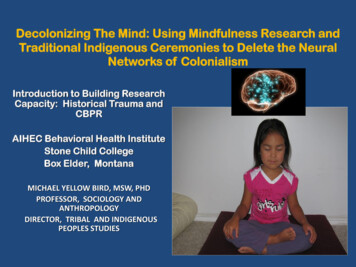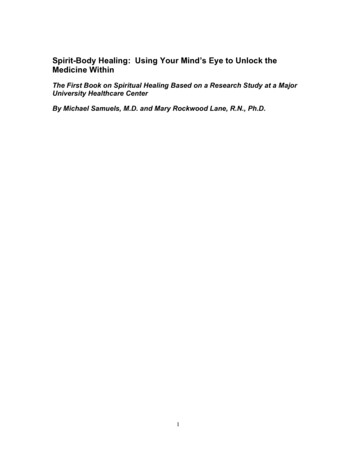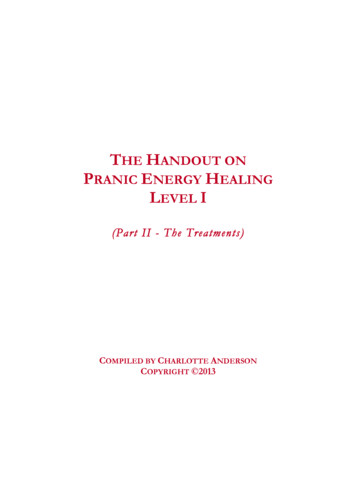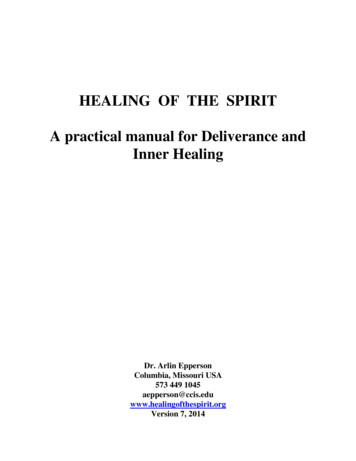
Transcription
Decolonizing The Mind: Using Mindfulness Research andTraditional Indigenous Ceremonies to Delete the NeuralNetworks of ColonialismIntroduction to Building ResearchCapacity: Historical Trauma andCBPRAIHEC Behavioral Health InstituteStone Child CollegeBox Elder, MontanaMICHAEL YELLOW BIRD, MSW, PHDPROFESSOR, SOCIOLOGY ANDANTHROPOLOGYDIRECTOR, TRIBAL AND INDIGENOUSPEOPLES STUDIES
Presentation Define MindfulnessPurpose of MindfulnessMindfulness Practice: MountainTrauma, Stress, Adverse Experiencesin the Brain Mindfulness– Neurobiology and Benefits– Breath Awareness Exercise Decolonization-- Neurodecolonization-- Traditional Contemplative Practices
Key Points of Workshop1)Neuroscience research confirms thatmindfulness practices can positively changeour brain’s structure and function.2)Mindfulness practices improve awareness andconcentration; ease the effects of trauma; raiseoptimism and fortify emotional selfregulation; create a sense of calm; increaseresilience; and reduce conflict.3)Mindfulness practices are easy to implementinto school curriculum; the cost ofimplementation low; they are culturallyneutral; and the evidence-base shows that theywork to improve health and well being.4)Mindfulness practices are an essential part oftraditional tribal practices, behaviors,ceremonies.
Potential:“Every single person hasEvery single human beingcan experience that —”David Lynch
Mindfulness DefinedMindfulness: Being deeply aware ofwhat is happening from momentto moment outside and inside us,without judging or attaching to thecontent, feelings, and emotionsthat arise.It refers to living deeply and richlyin the present moment and notresponding to life in a distractedand mechanical manner
Have a purpose“I am meditating in order to generate in mymind more positive energy, and to decreasethe negative energy for the benefit for myselfand all others.”
Mindfulness training in MSW programHumboldt State University, 2010-2011
Mindfulness at Fort Lewis College,Durango, Colorado, March 2016
Mindfulness at North Dakota StateUniversity, Fargo, ND, April 2016
Mindfulness at the Yellow Bird House,Arcata, California, 2012
Arundhati and Solana,Arcata, California, 2013
Arundhati Yellow Bird Practicing MindfulnessMeditation, Fargo, ND, Summer 2015
Mindfulness PracticeMountainMindfulnessMeditationExercise
Trauma, Stress, AdverseExperiences
The brain that does not bounce back from the trauma,stress, or adverse experiences can trigger a“hardwiring” of anxiety, fear, trauma, hopelessness,and disorganization.
Stress and the BrainChronic stress chemicals floods the brain with an enzyme (protein kinase C)that breaks down delicate the dendritic spines of the neurons in theprefrontal cortex (Dendritic spines are associated with memory andlearning).They canRepair whenstress iseliminated
Healthy Brain Chemistry
Stress, Depression, and TelomeresRuth Buczynski, PhD, 2015, NICABMIn one study, “Middle-aged people whowere physically active not only hadhigher aerobic capacities, but also longertelomeres than those who weresedentary. They had telomere lengthsthat were similar to people muchyounger than they were.”In another study, “Telomere lengths wereshortest for both depressed and healthyparticipants who were showing chronicstress. Many of the depressedparticipants exhibited disturbed cortisolregulation, which may explain why theyhad a higher overall probability of havingshorter telomere lengths.” (Norrback, et al.,2015).
Trauma eanyMother RatsHarryHarlowRhesusMonkeys
Telomeres Show Signs of Early-Life StressShaikh-Lesko, New Scientitist, April 7, 2014“Telomere length in children isassociated with a stressful homeenvironment, and genes thatencode certain neurotransmittersmay heighten the effect of thatstress.”In a study of family stability,“Children living in the moststressful environments hadtelomeres that were on average40 percent shorter than those ofthe children studied who wereliving in the most nurturingsettings.”Daniel Notterman, Penn State, 2007).
Chronic Stress and the BrainChronic stress distortskey brain chemicals:serotonin (sleep),dopamine (pleasure),and noradrenaline(energy levels).
Fearful ‘Memories’ Passed BetweenGenerations Through Genetic Code.An Important study suggests traumatic events that happento a parent could be passed down through their genesonto their children. Epigenetics: suggests that thisinheritance changes the way our genes express.“Parental olfactory experience influencesand neural structure in subsequentgenerations”(Nature Neuroscience, 2013)
Mother may pass daughters a brainwired for depression“Mother may pass on vulnerability to depression inmuch the same way they give their daughters greeneyes or curly hair – girls might inherit a brainstructure that’s predisposed to mood disorders, asmall US study suggests” (Reuters, February uroscience-mothers-depressio-idUSKCN0VR2WN
The Bullied Brain: Brain-DerivedNeurotrophic Factor6). BDNF is part of acascade of proteins,produced in thebrain that promotesneuron growth andstops neurons fromdying.
The Costs of Bullying in the Brain:Bully MiceBigger, aggressive white micebullied smaller brown micecreated social stress forsmaller brown mice. Theprolonged stress of beingbullying created an increaseof BDNF in the brain.This activated genes in the frontpart of the brain whichproduced high levels of socialanxiety, withdrawal,depression.(University of Texas, Southwestern Medical Center,2006)
The Neurobiology ofMindfulnessThe neuroscientific investigation of mindfulness focuses on the neural systems thatare utilized to achieve meditative states and to determine the effects that regularpractice of mindfulness has on brain structure.
Breath AwarenessPurpose: “I am meditating in order to generate in my mind morepositive energy, and to decrease the negative energy for thebenefit for myself and all others.”Set One:“Breathing in, I calm body and mind.”“Breathing out, I let go.”Set Two:Breathing in, “Dwelling in the present moment.”Breathing out, “This is the only moment.”
Changes happen Fast: 1 oH urs of mindfulnessAfter only 1 hours of practice (30(Posner, et al, )201
Significant , Lasting hC anges in 8 Weeks45 minutes of practice per dayfor 8 weeks changes brainempathy, and stress (SarahLazar, et al, 201)Reduction in Stress –
Mindfulness mediates conflictConflict-related Insula:Mindfulness meditationactivates the “insula, whichis associated with interoception,the sum of visceral and“gut” feelings that we experienceat any given moment,Is a key region involved inprocessing transient bodilysensations, thereby contributingto our experience of ‘selfness’”
Mindfulness increases EmotionalIntelligenceThe temporal parietaljunction becomes activatedduring meditation.This area is associated withthe ability to perceive theemotional and mental stateof others.This brain area is moreactive in meditators thannon-meditators, evenwhen they are notmeditating.
Mindfulness Improves Brain Waves
Mindfulness improves Brain WavesEEG Studies of Meditative States:Long-term meditators have higher levels ofalpha and theta band activity which isassociated with sleep and rest(Aftanas &Golocheikine, 2005; Andresen, 2000; J.M Davidson,1976; Delmonte, 1984)Meditation practices that emphasize deepphysical relaxation are more likely toproduce higher theta and delta activity(deep sleep); practices that focus onintensive concentration will have higheralpha and beta power (Didonna, 2009, p. 49)
Mindfulness Improves Brain WavesLutz et al, 2004 found that the ratio of gamma wave, as opposed toslow oscillatory activity was higher for Tibetan Buddhist monksthan for controls during a resting baseline. When the subjectsbegan a loving-kindness meditation the difference increasedsignificantly.Gamma waves are a pattern of brain waves associated withperception and neural consciousness. Long-term meditatorshave the ability to put the brain into a state in which it ismaximally sensitive and consumes power at a lower (or evenzero) rate.
Benefits of Mindfulness:Reducing stress, healing physical disease, improvingmood disorders and behavior, eliminating addictions,and enhancing learning capacities (Baer, 2003; Rystak, 2003;Howard, 2006; Begley, 2007; Doidge, 2007; Williams, Teasdale, Segal, & Kabat-Zinn, 2007;).
Effectiveness of MindfulnessThe effectiveness ofmindfulness has groups asdiverse as Fortune 500companies, the U.S. Marines,Police, and Adult and juvenileprisons offering formalmindfulness instruction tomembers of theirorganizations.
Benefits of MindfulnessMindfulness training has been successfully used to resolve anxiety,depression, obsessive compulsive disorders, and the Post-traumaticStress Disorder (PTSD) of military veteran's and survivors ofviolence.
Benefits of MindfulnessElementary and high schools studentswho learn these techniques reportimprovements in their concentration,focus, awareness, relaxation,self-management, memory,self-esteem, vitality, positiveaffectivity, optimism,and self-actualization(Brown and Ryan, 2003).
Decolonization
Theory and Practice of DecolonizationDecolonizationWell BeingEngaging inIndigenousbeliefs, values,and behaviorsDecolonization theory: Colonization is traumatic. Overcomingcolonization creates greater well being among Indigenous PeoplesDecolonization Practice: includes privileging and engaging inIndigenous philosophies, beliefs, practices, and values that countercolonialism and restore well being
What is Decolonization? “ the restoration of cultural practices, thinking, beliefs,and values that were taken away or abandoned (duringcolonization) but are relevant and necessary for survivaland well being. It is the birth and use of new ideas, thinking,technologies and lifestyles that contribute to theadvancement and empowerment of IndigenousPeoples.” (Source: Yellow Bird, 2008, Indigenous Social Work, 2008, Ashgate Press)
r worst enemy cannot harm you as much as your ownthoughts, unguarded. But once mastered, no one can help you asmuch, not even your father or your mother.” - Buddha
NeurodecolonizationRefers to all the ways of understanding how our brains, genetics, andimmune systems work when under the stresses of colonialism andduring optimal decolonization processes.
Neurodecolonization (Traditional ceremonies to train the mindand change the brain’s capacity to heal from the trauma of colonialism)
The Brain on Ceremony
Traditional Indigenous contemplative/mindfulness practicescan heal the effects of ColonialismArikara Engaged in CeremonialMindfulness in Traditional Earth lodge
Neurodecolonization: Sacred Object MeditationArikara brain on happiness,joy, optimism, feelings ofwell being
Singing to the Sacred Cedar
Ojibwe Snowshoe Dance
Purpose: “I am meditating in order to generate in my mind more positive energy, and to decrease the negative energy for the benefit for myself and all others.” Set One: “Breathing in, I calm body and mind.” “Breathing out, I let go.” Set Two: Breathing in, “Dwelling in










